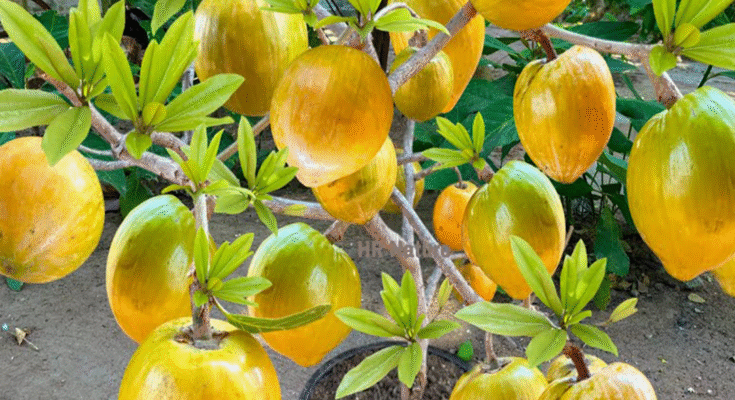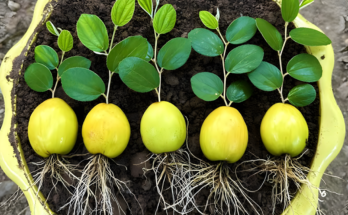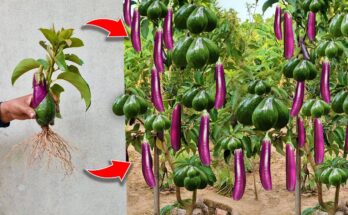How To Grow Caimito Egg Fruit Tree Cutting Faster With Potatoes | How to Growing Caimito Egg Fruit
Caimito, also known as Chrysophyllum cainito or “star apple,” is a tropical fruit tree loved for its creamy, sweet, and egg-like flavor. Some people also call it the “egg fruit tree” because of the soft yellow pulp inside that resembles the texture of a cooked egg yolk. While Caimito trees are usually grown from seeds, this method can take many years before they start fruiting. However, there is a faster and more exciting method — growing Caimito egg fruit from cuttings using potatoes. This unique technique can help stimulate root growth quickly and produce a strong, healthy tree that bears fruit much sooner than traditional planting.
Let’s explore this fascinating method step by step — from preparation to planting — and learn how to grow your own Caimito egg fruit tree successfully.
1. Understanding the Caimito Egg Fruit Tree
The Caimito egg fruit tree is a tropical evergreen that grows best in warm, humid climates. It can reach a height of 8 to 20 meters, producing glossy green leaves with a golden underside and round fruits that vary from purple to greenish-yellow. The fruit’s sweet and creamy texture makes it highly valued across Southeast Asia, Central America, and tropical islands.
However, growing Caimito from seed is often slow — it can take 5 to 8 years to produce fruit. Growing from cuttings, on the other hand, helps maintain the parent tree’s traits and drastically reduces fruiting time. Using potatoes in the process acts as a natural rooting booster.
2. Why Use Potatoes for Growing Cuttings?
Potatoes are rich in starch, phosphorus, and natural growth hormones that stimulate root formation. When you insert a cutting into a potato, it stays moist and protected, which encourages quick root development. The potato also provides a slow-release source of nutrients as it decomposes, feeding the young plant naturally.
This makes the potato not only a rooting medium but also an early organic fertilizer — a perfect combination for fast growth of Caimito cuttings.
3. Materials You Need
Before starting, prepare these simple materials:
- Fresh, healthy Caimito branch cutting (about 20–25 cm long)
- Medium-sized potato (firm and not sprouted)
- Sharp knife or pruning shears
- Rooting hormone powder or natural aloe vera gel (optional)
- Planting pot or polybag
- Rich soil mix (loam + compost + sand)
- Watering can or spray bottle
- Plastic wrap or clear bag (for humidity control)
4. Selecting and Preparing the Cutting
Choose a semi-hardwood branch from a healthy and mature Caimito tree — one that is neither too young nor too old. It should be flexible but firm when bent. Cut about 20–25 cm from the tip, ensuring there are at least 3–4 leaf nodes.
Remove the lower leaves, leaving only two or three leaves at the top. This helps reduce water loss and allows the cutting to focus its energy on root growth.
If you want to boost rooting success, dip the cut end into rooting hormone powder or fresh aloe vera gel — both are natural stimulants that encourage new roots to form faster.
5. Preparing the Potato
Take a medium-sized potato and make a hole in the center using a stick or knife — about 2–3 cm deep, just enough to insert your cutting snugly. Avoid piercing all the way through.
Insert the base of the Caimito cutting into the hole. The potato should firmly hold the cutting upright. Make sure the cutting goes deep enough for at least one node to be inside the potato, as that’s where roots will form.
6. Planting the Potato with Cutting
Next, fill your pot or polybag with a well-draining soil mix — one part loam soil, one part compost, and one part sand. This mix helps air circulation and prevents waterlogging, which could rot the potato.
Plant the entire potato with the cutting halfway into the soil. Gently press the soil around it to secure the position. Water the soil lightly — enough to keep it moist but not soaked.
To maintain humidity and protect the cutting from drying out, cover the pot with a clear plastic bag or plastic bottle. This acts like a mini greenhouse, trapping moisture and warmth inside.
7. Caring for the Caimito Cutting
Place the pot in a bright, shaded area — not under direct sunlight. Too much heat can damage the cutting before roots form. Keep the soil consistently moist by misting daily or watering every 2–3 days, depending on the climate.
After about 2 to 3 weeks, gently check by pulling the cutting slightly. If you feel resistance, it means roots have started forming. Once you notice new leaves growing, it’s a good sign that the cutting has successfully established itself.
You can then gradually expose it to more sunlight to strengthen the plant.
8. Transplanting to the Ground
After about 6 to 8 weeks, when the new plant looks strong and healthy, it’s time to transplant it into the ground or a larger pot. Choose a sunny location with rich, well-draining soil. Dig a hole deep enough to accommodate the potato and roots.
Before planting, you can add organic compost or decomposed cow manure to boost soil nutrients. Place the plant into the hole, cover it with soil, and water thoroughly.
Mulching around the base with dried leaves or straw helps retain moisture and control weeds.
9. Fertilizing and Watering
Caimito trees love organic matter. Feed the young tree every 2–3 weeks with organic fertilizer or compost tea. Once it grows larger, switch to a balanced fertilizer (10-10-10) every few months to encourage strong root and fruit development.
Water deeply once or twice a week, depending on rainfall and soil type. Avoid overwatering, as it can cause root rot.
10. Tips for Faster Growth and Fruiting
- Use young, disease-free cuttings for higher success.
- Keep the humidity high during the rooting stage.
- Add banana peel compost around the base to boost potassium for fruiting.
- Prune branches regularly to shape the tree and promote more flowering points.
- Ensure full sunlight once the plant is mature for better fruit quality.
Conclusion
Growing Caimito egg fruit trees from cuttings using potatoes is an innovative and efficient technique for gardeners who want faster results. The potato provides both moisture and nutrients, acting as a natural growth booster that helps the cutting root and thrive quickly. With proper care — including balanced watering, sunlight, and organic feeding — your Caimito tree can start flowering and bearing fruit in as little as 2–3 years, much sooner than growing from seed.



